Papers by Michael Bennett
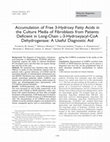
Clinical Chemistry, 2001
Background: The diagnosis of long-chain l-3-hydroxy-acyl-coenzyme A dehydrogenase (LCHAD) deficie... more Background: The diagnosis of long-chain l-3-hydroxy-acyl-coenzyme A dehydrogenase (LCHAD) deficiency frequently requires the study of cultured fibroblasts. We developed such a test that does not require disruption and loss of the cells. Methods: We measured free 3-hydroxy fatty acids (3-OHFAs) in media of skin fibroblasts cultures from 11 patients with a genetic deficiency of LCHAD and the associated disorder of mitochondrial trifunctional protein (MTFP). Fibroblasts were cultured for 24 h with 100 μmol/L nonisotopic palmitate added. 3-OHFAs were measured by selected-ion monitoring, stable-isotope dilution gas chromatography-mass spectrometry with [13C]-labeled internal standards. Results: 3-OH-hexadecanoic and 3-OH-tetradecanoic FAs were increased 14- and 11-fold, respectively, in all patients with LCHAD or MTFP deficiency when compared with control fibroblast cell lines after overnight incubation with palmitate. 3-OH-dodecanoic FA demonstrated a modest, fivefold increase in LCHAD-...
American Journal of Medical Genetics, 1994
Bannayan-Riley-Ruvalcaba syndrome (BRRS) is an autosomal dominant condition of macrocephaly in co... more Bannayan-Riley-Ruvalcaba syndrome (BRRS) is an autosomal dominant condition of macrocephaly in combination with lipomashemangiomas, hypotonia, developmental delay, and a lipid myopathy. The etiology of the lipid storage myopathy has been unclear. We describe a black boy with findings of BRRS who also has a defect in long-chain fatty acid oxidation expressed in cultured skin fibroblasts as a deficiency of longchain-L-3-hydroxyacyl-CoA dehydrogenase (L-CHAD). He also has an abnormal brain MRI and increased size of both lower limbs. We present this child because of his unusual combination of findings, and postulate that L-CHAD deficiency may be the cause of the lipid myopathy in BRRS.
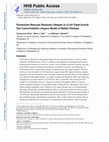
Journal of inherited metabolic disease, Mar 20, 2016
CLN3 disease (Spielmeyer-Vogt-Sjogren-Batten disease, previously known as classic juvenile neuron... more CLN3 disease (Spielmeyer-Vogt-Sjogren-Batten disease, previously known as classic juvenile neuronal ceroid lipofuscinosis, NCL) is a pediatric-onset progressive neurodegenerative disease characterized by progressive vision loss, seizures, loss of cognitive and motor function, and early death. While no precise biochemical mechanism or therapies are known, the pathogenesis of CLN3 disease involves intracellular calcium accumulation that may trigger apoptosis. Our prior work in in vitro cell models of CLN3 deficiency suggested that FDA-approved calcium channel antagonists may have therapeutic value. To further evaluate the potential efficacy of this approach in an otherwise untreatable disorder, we sought to compare the therapeutic effects and underlying mechanisms in an animal model of CLN3 disease. Here, we used the well-characterized XT7 complete cln-3 knockout strain of C. elegans to evaluate the therapeutic efficacy of calcium channel antagonist therapy in a living animal model of...
Clinica Chimica Acta, 2002
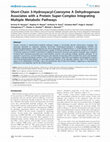
PloS one, 2012
Proteins involved in mitochondrial metabolic pathways engage in functionally relevant multi-enzym... more Proteins involved in mitochondrial metabolic pathways engage in functionally relevant multi-enzyme complexes. We previously described an interaction between short-chain 3-hydroxyacyl-coenzyme A dehydrogenase (SCHAD) and glutamate dehydrogenase (GDH) explaining the clinical phenotype of hyperinsulinism in SCHAD-deficient patients and adding SCHAD to the list of mitochondrial proteins capable of forming functional, multi-pathway complexes. In this work, we provide evidence of SCHAD's involvement in additional interactions forming tissue-specific metabolic super complexes involving both membrane-associated and matrix-dwelling enzymes and spanning multiple metabolic pathways. As an example, in murine liver, we find SCHAD interaction with aspartate transaminase (AST) and GDH from amino acid metabolic pathways, carbamoyl phosphate synthase I (CPS-1) from ureagenesis, other fatty acid oxidation and ketogenesis enzymes and fructose-bisphosphate aldolase, an extra-mitochondrial enzyme of...
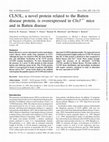
Batten disease is a severe autosomal recessive neurodegen-erative disease which results from muta... more Batten disease is a severe autosomal recessive neurodegen-erative disease which results from mutations in CLN3. Although the gene was cloned in 1995, the tissue distribu-tion and subcellular localization of the CLN3 protein (CLN3P) remains inconclusive. We have demonstrated the presence of a novel 33 kDa protein in both normal human and wild-type mouse brain. This 33 kDa protein, which is overexpressed in brains of patients with Batten disease and in Cln3–/ – mouse brain, binds to the antibody raisedagainst thepeptide sequenceofCLN3Pandresults in aberrantCLN3P localization studies.We expressed anovel 33 kDa protein that is highly similar to CLN3P.We showed that the 33 kDa protein is identical to that recognized in Batten disease and Cln3–/ – brain. These studies strongly suggest the presence of an alternative CLN3-like (CLN3L) product in Batten disease. Previous studies of CLN3P tissue distribution and intracellular localization will require extensive reanalysis in order to determin...

Placenta, 2002
Fetal disorders of mitochondrial fatty acid oxidation have recently been associated with obstetri... more Fetal disorders of mitochondrial fatty acid oxidation have recently been associated with obstetric complications including pre-eclampsia, Hemolysis, Elevated Liver enzymes, Low Platelets (HELLP) syndrome, placental floor infarct, and Acute Fatty Liver of Pregnancy (AFLP). These diseases occur in about a third of the mothers who are heterozygous for a defect in long chain 3-hydroxyacyl-CoA dehydrogenase (LCHAD) enzyme and who bear a fetus homozygous for the defect. The mechanism of this association is not clearly understood. In this study, we provide evidence that the placenta may be the site of production of toxic intermediates of fatty acid metabolism, which accumulate to cause liver damage in the mother. We show that two critical enzymes of long chain fatty acid metabolism, long chain 3-hydroxyacyl-CoA dehydrogenase (LCHAD) and short chain 3-hydroxyacyl-CoA dehydrogenase (SCHAD), are active in the normal human placenta. There is an inverse correlation between the enzyme activity of both the enzymes and maternal gestational age during the second and third trimesters. We believe that the demonstration of fatty acid oxidation enzyme activity by the placenta is the first step towards assessing a possible role for fetal/placental fatty acid oxidation defects in the pathogenesis of a subset of pregnancy complications.
Newborn and Infant Nursing Reviews, 2008
With recent advances in laboratory technology with tandem mass spectrometry (MS/MS), the number o... more With recent advances in laboratory technology with tandem mass spectrometry (MS/MS), the number of infants identified with a fatty acid oxidation disorder has increased dramatically. Disorders of fatty acid oxidation comprise one of the most rapidly growing groups within the field of errors of metabolism. This review will explore the recent developments in newborn screening related to the use of tandem mass spectrometry and disorders of fatty acid oxidation.

Muscle & Nerve, 2002
Carnitine palmitoyltransferase (CPT) II deficiency disorders are clinically very variable. To exa... more Carnitine palmitoyltransferase (CPT) II deficiency disorders are clinically very variable. To examine the cause(s) of variable symptoms in first-degree relatives with CPT II deficiency, four sisters with various combinations of mutations and polymorphisms in the CPT2 gene were studied, together with 20 sedentary and 24 trained healthy female subjects. One sister, whose symptoms began at age 7 years, was more severely affected than her older sister, whose symptoms began at age 16 years; both were compound heterozygotes for the common S113L mutation and Q413fs, and for the common CPT2 polymorphisms, V3681 and M647V. A third sister became hypoglycemic with fasting, was heterozygous for the S113L mutation, and homozygous for the polymorphism variants. The fourth sister was asymptomatic, heterozygous for the Q413fs mutation, and homozygous for the normal polymorphisms. Residual CPT II activity in skeletal muscle and cultured skin fibroblasts from the two myopathic sisters, and palmitate oxidation in fibrobasts, were abnormally low; cellular and total body fat oxidation were also diminished. Muscle function and fat oxidation were nomal at rest, but a switch to carbohydrate utilization occurred at lower exercise intensities than in sedentary and trained individuals, respectively. Reliance on carbohydrates during stress and hormonal alterations may explain, in part, the variance in ages of onset and serverity of symptoms in myopathic patients.
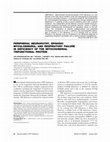
Muscle & Nerve, 2004
Mitochondrial trifunctional protein (TFP) deficiency is a rare disorder of the fatty acid -oxida... more Mitochondrial trifunctional protein (TFP) deficiency is a rare disorder of the fatty acid -oxidation cycle with heterogeneous phenotypes and occurs secondary to either ␣or -subunit mutations. We characterized the neuromyopathic phenotype of TFP deficiency through adolescence or adulthood in 11 patients, 8 with -subunit mutations and 3 with ␣-subunit mutations. Two independent clinical features occurred: infantile-onset progressive peripheral neuropathy and episodic exercise-, illness-or fastinginduced rhabdomyolysis accompanied by respiratory failure (in five patients). The combination of episodic rhabdomyolysis and peripheral neuropathy occurred in 10 of the 11 patients. The neuromyopathic phenotype is common in TFP deficiency (11 of 27 families from our cohort). Therefore, this disorder must be considered in the differential diagnosis of progressive peripheral neuropathy with or without episodic myoglobinuria.
Molecular Genetics and Metabolism, 2001
Malonyl-CoA decarboxylase deficiency is a rare inborn error of metabolism. It has been suggested ... more Malonyl-CoA decarboxylase deficiency is a rare inborn error of metabolism. It has been suggested but never demonstrated that many of the clinical features arise due to inhibition of mitochondrial fatty acid oxidation by accumulated malonyl-CoA. We studied the oxidation of fatty acids in cultured skin fibroblasts from a recently described patient with malonyl-CoA decarboxylase deficiency. There was a marked reduction in the oxidation of palmitic and myristic acids both under baseline conditions and when the cells were cultured in the presence of high concentrations of acetate, a malonyl-CoA precursor. These results suggest that there is inhibition of fatty acid oxidation in malonyl-CoA decarboxylase deficiency and that this inhibition may be related to some of the clinical phenotypes.
Molecular Genetics and Metabolism, 2007
The Journal of Pediatrics, 1995
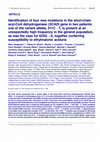
Human Molecular Genetics, 1998
We have shown previously that a variant allele of the short-chain acyl-CoA dehydrogenase (SCAD) g... more We have shown previously that a variant allele of the short-chain acyl-CoA dehydrogenase (SCAD) gene, 625G→A, is present in homozygous form in 7% of control individuals and in 60% of 135 patients with elevated urinary excretion of ethylmalonic acid (EMA). We have now characterized three disease-causing mutations (confirmed by lack of enzyme activity after expression in COS-7 cells) and a new susceptibility variant in the SCAD gene of two patients with SCAD deficiency, and investigated their frequency in patients with elevated EMA excretion. The first SCAD-deficient patient was a compound heterozygote for two mutations, 274G→T and 529T→C. These mutations were not present in 98 normal control alleles, but the 529T→C mutation was found in one allele among 133 patients with elevated EMA excretion. The second patient carried a 1147C→T mutation and the 625G→A polymorphism in one allele, and a single point mutation, 511C→T, in the other. The 1147C→T mutation was not present in 98 normal alleles, but was detected in three alleles of 133 patients with elevated EMA excretion, consistently as a 625A-1147T allele. On the other hand, the 511C→T mutation was present in 13 of 130 and 15 of 67 625G alleles, respectively, of normal controls and patients with elevated EMA excretion, and was never associated with the 625A variant
Human Molecular Genetics, 1999
Germline mutations in the tumour suppressor gene PTEN have been implicated in two hamartoma syndr... more Germline mutations in the tumour suppressor gene PTEN have been implicated in two hamartoma syndromes that exhibit some clinical overlap, Cowden syndrome (CS) and Bannayan-Riley-Ruvalcaba syndrome (BRR). PTEN maps to 10q23 and encodes a dual specificity phosphatase, a substrate of which is phosphati
Current Opinion in Pediatrics, 1998
Inborn errors of fatty acid oxidation (FAO) represent a group of metabolic disorders that has bro... more Inborn errors of fatty acid oxidation (FAO) represent a group of metabolic disorders that has brought forward many interesting developments, as highlighted by the rapid pace of discovery of new defects and by the recognition of an ever-increasing spectrum of clinical phenotypes. This review includes a clinical and biochemical summary of the FAO disorders known to date, a synopsis of four recently discovered defects (short-chain 3-hydroxy acyl-CoA [coenzyme A] dehydrogenase deficiency, medium-chain 3-ketoacyl-CoA thiolase deficiency, 3-hydroxy-3-methylglutaryl-CoA synthase deficiency, and long-chain fatty acid transport deficiency) and of two susceptibility variations in the short-chain acyl-CoA dehydrogenase gene, and guidelines for the biochemical work-up of candidate patients.

Current Molecular Medicine, 2007
Juvenile neuronal ceroid-lipofuscinosis (JNCL, Batten disease, Spielmeyer-Vogt-Sjogren disease, C... more Juvenile neuronal ceroid-lipofuscinosis (JNCL, Batten disease, Spielmeyer-Vogt-Sjogren disease, CLN3) is the most common inherited, autosomal recessive, neurodegenerative disorder in man. Like the other neuronal ceroid-lipofuscinoses, it is characterized by progressive loss of vision, seizures, and loss of cognitive and motor functions, leading to premature demise. JNCL is caused by mutations of CLN3, a gene that encodes a hydrophobic transmembrane protein, which localizes to membrane lipid rafts in lysosomes, endosomes, synaptosomes, and cell membrane. While the primary function of the CLN3 protein (CLN3P) may be debated, its absence affects numerous cellular functions including pH regulation, arginine transport, membrane trafficking, and apoptosis. We have recently suggested that the unifying primary function of CLN3P may be in a novel palmitoyl-protein Delta-9 desaturase (PPD) activity that in our opinion could explain all of the various functional abnormalities seen in the JNCL cells. Another group of researchers has recently shown a correlation between the CLN3P expression and the synthesis of bis(monoacylglycerol)phosphate (BMP) and suggested that CLN3P may play a role in the biosynthesis of BMP. In this review, following an introduction to the neuronal ceroid-lipofuscinoses, we provide a brief overview and an update of the most recent research in JNCL, specifically that related to the function of CLN3P.

Uploads
Papers by Michael Bennett